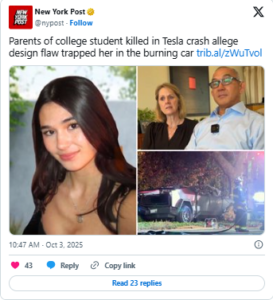Student dies in fire after being trapped inside her Tesla.
A holiday road trip turned into horror when 19-year-old Krysta Tsukahara was burned alive inside a Tesla Cybertruck after it burst into flames following a crash. The Thanksgiving tragedy claimed three young lives — and has now ignited a wave of lawsuits against Tesla. Families say the victims might have survived if they could have opened the doors.

On November 27, 2024, Krysta and three friends were driving in Oakland, California, when their Cybertruck hit a retaining wall and caught fire. Police arrived to find the vehicle engulfed in flames. Krysta, driver Soren Dixon (19), and passenger Jack Nelson (20) were trapped inside, while the only survivor, Jordan Miller, escaped after a bystander smashed a window with a tree branch.
Toxicology reports revealed drugs and alcohol in the system of the driver and passengers. Yet, the families argue Tesla bears responsibility — not for the crash itself, but for a deadly door system failure. The lawsuits claim the electronic door release malfunctioned after the crash, and the manual backup was nearly impossible to locate in smoke and darkness. Tesla’s design, they say, turned a survivable crash into a death trap.
The lawsuits accuse Tesla of knowingly selling unsafe vehicles and ignoring prior complaints about door malfunctions. Krysta’s parents say she was alive after the impact — but died calling for help. Attorneys call the Cybertruck “a coffin on wheels.”
Tesla has faced multiple recalls and safety probes since the Cybertruck’s 2023 debut, but this case could redefine accountability for high-tech vehicles. As investigations continue, families demand justice — and answers to one haunting question: Why couldn’t they get out?
